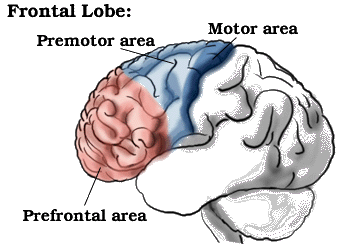Frontal Lobes of the Brain – The Higher Brain Functions
Frontal Lobes of the Human Brain
Call me at 800-992-9447
The frontal lobes are the largest lobes of the brain. The frontal lobes are the last parts of the brain to develop as a person ages and the part of the human brain that is most different from other mammals and primates.
We learn to become adults in our frontal lobes. They comprise about one third of surface area of the brain’s hemispheres. The frontal lobes have these principal gyri (the hills of the brain):
- The Precental;
- Premotor; and
- Prefrontal.
Precentral Division of the Frontal Lobes
The precentral division is at the back of the frontal lobes. The precental division is in the gyrus (ridge) just before front of the central sulcus (valley). This is right along the edge between the blue and the white in the picture on the left. This is the primary motor (movement) area of the brain. (It is labeled motor area on the photograph) It has important connections with the cerebellum, basal ganglia and motor divisions of the thalamus.
Premotor Division of the Frontal Lobes
The premotor division is situated just forward of the Precentral or Motor area. This is the area of the brain where motor skills and practiced behaviors are learned. It is where movement which needs to involve planning, guidance and a sensory feel is influenced. While all of its functions are still not well understood, it may have a role in the control of behavior. It may also help in understand the actions of others. It might be involved in applying abstract concepts to performing specific tasks. It may be the sensei of the mind.
Prefrontal Division of the Frontal Lobes
The brain’s feedback loops run through the frontal lobes. The prefrontal cortex contains the connections between the major sensory and major motor systems, it is the place where information converges in the brain. The prefrontal cortex is responsible for attention, integration, formulation. It executes plans and actions. It monitors, modifies and judges all input from throughout the nervous system. In other words, it is involved in just about everything. It has been called the “seat of consciousness”. The prefrontal lobes do that which makes us most human.
As the frontal lobes do the most, injury to them can cause the most problems. The frontal lobes are clearly the most important areas that we will address on Brain Injury Help. Further, positioned adjacent to the front of the head and the underside of the skull, the frontal lobes are extremely vulnerable to injury. That vulnerability is far greater with high speed modern accidents, than with the anthropological risks of human life. Much of our treatment of Brain Injury Symptomotology will be addressing frontal lobe deficits, particularly executive functioning deficits. It is in understanding frontal deficits that our TBI Voices project provides our biggest contribution.
Yet even those deficits which are not identified as frontal, can originate or be made worse because of frontal lobe injury. Injury to the feedback loop and connections, will cause dysfunction, even if neurons which are the source of the data are left unharmed.




